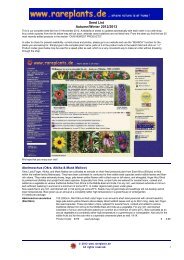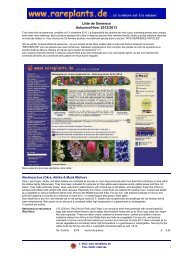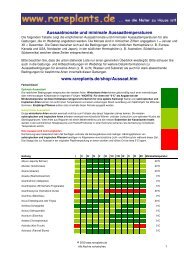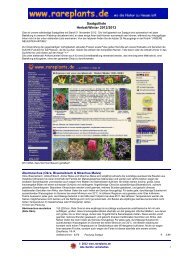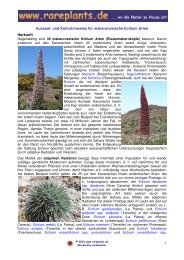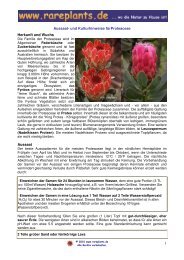Lista de Semillas Otoño/Invierno 2012/2013 - Bjorn Malkmus Rare ...
Lista de Semillas Otoño/Invierno 2012/2013 - Bjorn Malkmus Rare ...
Lista de Semillas Otoño/Invierno 2012/2013 - Bjorn Malkmus Rare ...
Create successful ePaper yourself
Turn your PDF publications into a flip-book with our unique Google optimized e-Paper software.
Aichryson (Mice Ears)<br />
"Oreja <strong>de</strong> Ratón" (Mice Ears) are called most plants of this small genus by the Canary people. They are close to Aeonium in the family of<br />
Crassulaceae and grow in rather sha<strong>de</strong>d and slightly moist places in the laurel or pine tree forest on the islands. They make lose racemes<br />
of several hundred sulfur to greenish-yellow, miniature star like flowers above usually <strong>de</strong>nsely pubescent succulent leaves. All are easily<br />
cultivated in any rich, slightly moist soil in a sunny to partially sha<strong>de</strong>d spot throughout the year. Require careful watering and preferably full<br />
sun in winter. Will readily self-sow after flowering, when most plants will die down. For more cultivation information please have at look at<br />
this page:http://www.rareplants.<strong>de</strong>/shop/prodtype.asp?strParents=555&CAT_ID=558 Sowing and cultivation of Aeonium, Aichryson and<br />
Greenovia.<br />
Sow dust-like seeds flat on any well drained soil, keep soil slightly moist from beneath. Do not cover seeds with soil.<br />
50 semillas por sobre.<br />
Aviso legal: De acuerdo con las leyes alemanas nacionales (BNatSchG y BArtSchV) tan bien como las convenciones a nivel europeo<br />
(Convención <strong>de</strong> Berna) e internacional (Convention on International Tra<strong>de</strong> in Endangered Species of Wild Fauna and Flora - CITES) no<br />
ven<strong>de</strong>mos ningún material tal como semillas proveniendo <strong>de</strong> plantas salvajes protegidas. Las semillas <strong>de</strong> dichas plantas protegidas<br />
<strong>de</strong>rivan exclusivamente <strong>de</strong> plantas propagadas artificialmente en cultivos hortículos en Alemania respectivamente en el Líbano, don<strong>de</strong> las<br />
plantas se han tomado en cultivo a finales <strong>de</strong> los años 70 y al principio <strong>de</strong> los años 80 <strong>de</strong>l siglo pasado.<br />
Aichryson bollei Exclusive 10 (15)cm, small Aichryson reaching only some 10 to 15cm in height. Native of sha<strong>de</strong>d to sunny spots in<br />
rocks crevices in only few places in western La Palma. Makes <strong>de</strong>nsely hairy, transverse elliptic leaves,<br />
sha<strong>de</strong>d in red with red striped beneath in a sunny place. Rather large, dark yellow flowers from May to<br />
June. Barranco <strong>de</strong> Izcagua (740m).<br />
Aichryson divaricatum<br />
Exclusive<br />
No. <strong>de</strong> artículo: 2766 sobre <strong>de</strong> semillas<br />
€ 4,99<br />
20(30)cm, en<strong>de</strong>mic of partially sha<strong>de</strong>d and slightly moist soils mainly in the laurel forest zone on the<br />
island of Ma<strong>de</strong>ira, as the other three Aichryson species from Ma<strong>de</strong>ira, it is rarely seen in cultivation.<br />
Makes small plants of 20(30)cm in height with ovoid, smooth, dark green, shining leaves and many<br />
greenish yellow to bright yellow star like flowers from July to August. Usually grows as an annual to<br />
biannual, but it may be easily propagates from seeds or by means of cuttings from branching specimens.<br />
From semi-moist rock walls in the Cal<strong>de</strong>rão do Inferno.<br />
No. <strong>de</strong> artículo: 2768 sobre <strong>de</strong> semillas<br />
€ 4,99<br />
Aichryson laxum 20 (50)cm, can be found on almost all islands and is probably one of the most attractive species within<br />
this genus due to its large ovoid dark green leaves which are very hairy on both si<strong>de</strong>s. The inflorescence<br />
is freely <strong>de</strong>veloped and consists of up to 50 large star-like, yellow flowers. In or<strong>de</strong>r to promote vegetative<br />
growth, the inflorescence should be cut off in time, otherwise this species will naturally grow as a<br />
biannual. Seeds are produced in abundance and will easily sow themselves. For any humus rich, well<br />
drained soil in a partially sha<strong>de</strong>d to sunny spot. Seeds from populations in the drier laurel forests in Los<br />
Erjos (Tenerife), Barranco <strong>de</strong>l Río/Roque Faro (La Palma), and Barranco <strong>de</strong> Moya (Gran Canaria).<br />
Aichryson laxum var.<br />
gomerense var. nov. ined.<br />
Exclusive<br />
Aichryson palmense<br />
Exclusive<br />
Aichryson parlatorei<br />
Exclusive<br />
Aichryson punctatum<br />
Exclusivo<br />
No. <strong>de</strong> artículo: 2769 sobre <strong>de</strong> semillas (ex Tenerife)<br />
€ 3,99<br />
No. <strong>de</strong> artículo: 3040 sobre <strong>de</strong> semillas (ex La Palma)<br />
€ 3,99<br />
No. <strong>de</strong> artículo: 5123 sobre <strong>de</strong> semillas (ex El Hierro)<br />
€ 2,99<br />
No. <strong>de</strong> artículo: 3413 sobre <strong>de</strong> semillas (ex Gran Canaria)<br />
€ 2,99<br />
40 (60)cm, an only in 2001 by <strong>Malkmus</strong>, B. recognized new variety, much larger in all aspects, reaching<br />
up to 60cm in height. Makes strongly pubescent leaves up to 6cm ø at their tip. Its inflorescence reaches<br />
an impressive 25cm ø and more with some 200 to 500 bright yellow star-like flowers. Flowering from June<br />
through August. Native of La Gomera, where it is very common in partially sunny, slightly moist spots in<br />
the laurel forest. VI-VIII.<br />
No. <strong>de</strong> artículo: 2795 sobre <strong>de</strong> semillas<br />
€ 4,99<br />
20cm, similar Aichryson laxum, yet more compact (reaches up to 20cm in height) and has leaves twice<br />
the size, which are very sticky. This rarely seen species is en<strong>de</strong>mic to slightly moist, open spots on rocky<br />
walls in the lower parts of the laurel forest of La Palma. Makes a compact inflorescence with rather large,<br />
bright sulfur yellow flowers. Easily raised from seeds, which are set in abundance. On good conditions<br />
plants may grow as perennials, yet cuttings from non flowering plants will root easily. Seeds from two<br />
populations are available: from the Barranco <strong>de</strong>l Agua at some 620m and Las Moraditas/Barranco <strong>de</strong><br />
Gallegos.<br />
No. <strong>de</strong> artículo: 2815 sobre <strong>de</strong> semillas (ex Bco. <strong>de</strong>l Agua)<br />
€ 2,99<br />
No. <strong>de</strong> artículo: 3420 sobre <strong>de</strong> semillas (ex Bco. <strong>de</strong> Gallegos)<br />
€ 4,99<br />
5 (10)cm, an annual dwarf species, which is native to all western islands, where it prefers rich and slightly<br />
moist soils in partial sha<strong>de</strong>. The bright yellow flowers are rather large for the overall plant's size. The small<br />
rhomboid, fresh green leaves show few blackish markings on their edges. Seeds from two populations<br />
are available: Valle <strong>de</strong>l Gran Rey, 540m, La Gomera (formerly listed as Aichryson spec. 1) and Barranco<br />
<strong>de</strong> Izcagua, 450m, La Palma.<br />
No. <strong>de</strong> artículo: 3415 sobre <strong>de</strong> semillas (ex La Palma)<br />
€ 4,99<br />
10 (20)cm, similar to Aichryson pachycaulon, yet smaller in all parts, reaching some 10cm to 20cm in<br />
height. The dark green rhomboid leaves have margins with small blackish dots and all parts are covered<br />
with short fine hairs. From sha<strong>de</strong>d, slightly moist rock crevices on all western islands including Gran<br />
Canaria. Makes numerous intense yellow flowers in a lax inflorescence. Easily raised from seeds when<br />
plants have died down after flowering. For any humus rich, always slightly moist soil in a partially sha<strong>de</strong>d<br />
spot. Seeds from four populations are available: small-leafed plants from sun exposed rock walls in the<br />
north-eastern of La Palma (Fuente <strong>de</strong> San Marcos, Barranco <strong>de</strong>l Río) in the Fayal-Brezal zone (formerly<br />
listed as Aichryson spec. 2), Pico <strong>de</strong> Garajonay, La Gomera, large-leafed plants from Artenara, Gran<br />
Canaria and El Golfo, El Hierro at some 900m. VI-VIII.<br />
© <strong>2012</strong> www.rareplants.<strong>de</strong><br />
Todos los <strong>de</strong>rechos reservados.<br />
20




